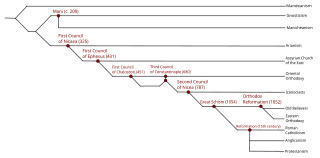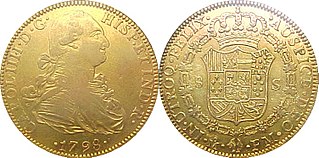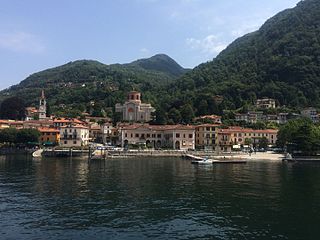
A religious denomination is a subgroup within a religion that operates under a common name, tradition, and identity.

The tenge is the currency of Kazakhstan. It is divided into 100 tıyn. The ISO-4217 code is KZT.

The lek is the official currency of Albania. It was formerly subdivided into 100 qindarka, but qindarka are no longer issued.

A Christian denomination is a distinct religious body within Christianity, identified by traits such as a name, organization, leadership and doctrine. Individual bodies, however, may use alternative terms to describe themselves, such as church or sometimes fellowship. Divisions between one group and another are defined by authority and doctrine; issues such as the nature of Jesus, the authority of apostolic succession, eschatology, and papal primacy may separate one denomination from another. Groups of denominations—often sharing broadly similar beliefs, practices, and historical ties—are sometimes known as "branches of Christianity". These branches differ in many ways, especially through differences in practices and belief.

The lira was the currency of Italy between 1861 and 2002 and of the Albanian Kingdom between 1941 and 1943. Between 1999 and 2002, the Italian lira was officially a national subunit of the euro. However, cash payments could be made in lira only, as euro coins or notes were not yet available. The lira was also the currency of the Napoleonic Kingdom of Italy between 1807 and 1814.

U.S. Catanzaro 1929 is an Italian football club based in Catanzaro, Calabria.

The doubloon was a two-escudo or 32-real gold coin; weighing 6.867 grams in 1537, and 6.766 grams from 1728, of .92 fine gold. Doubloons were minted in Spain and the viceroyalties of New Spain, Peru, and Nueva Granada. The term was first used to describe the golden excelente either because of its value of two ducats or because of the double portrait of Ferdinand and Isabella.

The Lutheran Book of Worship (LBW) is a worship book and hymnal used by several Lutheran denominations in North America. In the Evangelical Lutheran Church in America, the LBW is sometimes called the "green book", as opposed to With One Voice, a blue-covered supplement; or the previous Service Book and Hymnal, bound in red; or The Lutheran Hymnal, which is also bound in red, but with a simple gold cross.

Cefuroxime axetil, sold under the brand name Zinnat among others, is a second generation oral cephalosporin antibiotic.

The Somalo was the currency of the Trust Territory of Somaliland administered by Italy between 1950 and 1960. The "Somalo" remained officially in use in the newly created Republic of Somalia until 1962. It was subdivided In 100 Centesimi.
Licensing means renting or leasing of an intangible asset. It is a process of creating and managing contracts between the owner of a brand and a company or individual who wants to use the brand in association with a product, for an agreed period of time, within an agreed territory. Licensing is used by brand owners to extend a trademark or character onto products of a completely different nature.

Laveno-Mombello is a comune (municipality) in the Province of Varese in the Italian region Lombardy, located about 75 kilometres (47 mi) northwest of Milan and about 25 kilometres (16 mi) northwest of Varese. As of 31 December 2004, it had a population of 8,991 and an area of 25.9 square kilometres (10.0 sq mi).

Religion in Italy is characterised by the predominance of Christianity and an increasing diversity of religious practices, beliefs and denominations. Most Christians in Italy adhere to the Catholic Church, whose headquarters are in Vatican City, Rome.
The Union of Methodist and Waldensian Churches is an Italian united Protestant denomination.
Prodotto agroalimentare tradizionale, usually abbreviated to PAT, is an official approval for traditional Italian regional food products similar to the Protected Geographical Status of the European Union. A list of approved products is published by the Ministry of Agricultural, Food and Forestry Policies. It lists only products that do not qualify for pan-European approval, and as such PAT is only applicable within Italy.

Belarus used the postage stamps of the Soviet Union from 1917 to 1991.
The combination of dutasteride and tamsulosin, sold under the brand names Combodart, Duodart, and Jalyn, is a medication produced by GlaxoSmithKline for the treatment of adult male symptomatic benign prostatic hyperplasia (BPH).
It is a combination of two previously existing drugs: tamsulosin, brand name Flomax, and dutasteride, brand name Avodart. It contains 0.4 mg of tamsulosin Hydrochloride and 0.5 mg of dutasteride.

Drug nomenclature is the systematic naming of drugs, especially pharmaceutical drugs. In the majority of circumstances, drugs have 3 types of names: chemical names, the most important of which is the IUPAC name; generic or nonproprietary names, the most important of which are the International Nonproprietary Names (INNs); and trade names, which are brand names. Generic names for drugs are nowadays constructed out of affixes and stems that classify the drugs into different categories and also separate drugs within categories. A marketed drug might also have a company code or compound code.

Fluocortin butyl, or fluocortin 21-butylate, is a synthetic glucocorticoid corticosteroid which is marketed in Germany, Belgium, Luxembourg, Spain, and Italy. Chemically, it is the butyl ester derivative of fluocortin.

















